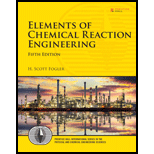
(a)
Interpretation:
The equilibrium constant
Concept Information:
Forward Reaction: This type of reaction has involved irreversible, if obtained product cannot be converted back in to respective reactants under the same conditions. Backward Reaction: This type of reaction process involved a reversible, if the products can be converted into a back to reactants.
Equilibrium constant: Concentration of the products to the respective molar concentration of reactants it is called equilibrium constant. If the K value is less than one the reaction will move to the left side and the K values is higher (or) greater than one the reaction will move to the right side of reaction.
Rate equation for the general reaction
The rate of the reaction is proportinal to the concentration of A to the power of x, is
The rate of the reaction is proportional to the concentration of B to the power of y is
Then the rate equation becomes,
Reversible Reaction and equilibrium conversion: The equilibrium, the concentration of the species is related by the relationship dictated by thermodynamic equation.
(b)
Interpretation:
The equilibrium constant value should be determined given liquid-phase reaction.
Concept Information:
Forward Reaction: This type of reaction has involved irreversible, if obtained product cannot be converted back in to respective reactants under the same conditions. Backward Reaction: This type of reaction process involved a reversible, if the products can be converted into a back to reactants.
Equilibrium constant: Concentration of the products to the respective molar concentration of reactants it is called equilibrium constant. If the K value is less than one the reaction will move to the left side and the K values is higher (or) greater than one the reaction will move to the right side of reaction.
Rate equation for the general reaction
The rate of the reaction is proportinal to the concentration of A to the power of x, is
The rate of the reaction is proportional to the concentration of B to the power of y is
Then the rate equation becomes,
(c)
Interpretation:
Equilibrium constant for the given reaction has to be written as a function of conversion, numerically evaluating all possible symbols.
Concept Information:
Rate of a reaction: It represents the speed at which a chemical reaction runs. How much concentration of substrates (reactants) consumed and how much concentration of targets (products) formed in a unit of time is said to be rate of reaction.
Rate equation for the general reaction
The rate of the reaction is proportinal to the concentration of A to the power of x, is
The rate of the reaction is proportional to the concentration of B to the power of y is
Then the rate equation becomes,
(d)
Interpretation:
Equilibrium constant for the given reaction has to be written as a function of conversion, numerically evaluating all possible symbols.
Concept Information:
Rate of a reaction: It represents the speed at which a chemical reaction runs. How much concentration of substrates (reactants) consumed and how much concentration of targets (products) formed in a unit of time is said to be rate of reaction.
Rate equation for the general reaction
The rate of the reaction is proportinal to the concentration of A to the power of x, is
The rate of the reaction is proportional to the concentration of B to the power of y is
Then the rate equation becomes,
Want to see the full answer?
Check out a sample textbook solution
Chapter 4 Solutions
Elements of Chemical Reaction Engineering (5th Edition) (Prentice Hall International Series in the Physical and Chemical Engineering Sciences)
 Introduction to Chemical Engineering Thermodynami...Chemical EngineeringISBN:9781259696527Author:J.M. Smith Termodinamica en ingenieria quimica, Hendrick C Van Ness, Michael Abbott, Mark SwihartPublisher:McGraw-Hill Education
Introduction to Chemical Engineering Thermodynami...Chemical EngineeringISBN:9781259696527Author:J.M. Smith Termodinamica en ingenieria quimica, Hendrick C Van Ness, Michael Abbott, Mark SwihartPublisher:McGraw-Hill Education Elementary Principles of Chemical Processes, Bind...Chemical EngineeringISBN:9781118431221Author:Richard M. Felder, Ronald W. Rousseau, Lisa G. BullardPublisher:WILEY
Elementary Principles of Chemical Processes, Bind...Chemical EngineeringISBN:9781118431221Author:Richard M. Felder, Ronald W. Rousseau, Lisa G. BullardPublisher:WILEY Elements of Chemical Reaction Engineering (5th Ed...Chemical EngineeringISBN:9780133887518Author:H. Scott FoglerPublisher:Prentice Hall
Elements of Chemical Reaction Engineering (5th Ed...Chemical EngineeringISBN:9780133887518Author:H. Scott FoglerPublisher:Prentice Hall
 Industrial Plastics: Theory and ApplicationsChemical EngineeringISBN:9781285061238Author:Lokensgard, ErikPublisher:Delmar Cengage Learning
Industrial Plastics: Theory and ApplicationsChemical EngineeringISBN:9781285061238Author:Lokensgard, ErikPublisher:Delmar Cengage Learning Unit Operations of Chemical EngineeringChemical EngineeringISBN:9780072848236Author:Warren McCabe, Julian C. Smith, Peter HarriottPublisher:McGraw-Hill Companies, The
Unit Operations of Chemical EngineeringChemical EngineeringISBN:9780072848236Author:Warren McCabe, Julian C. Smith, Peter HarriottPublisher:McGraw-Hill Companies, The





